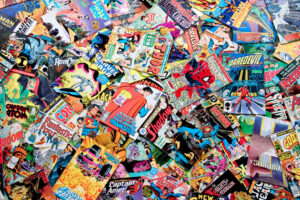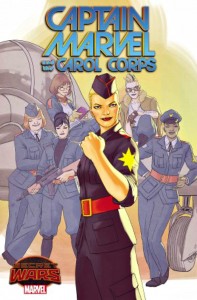 Another big week — Marvel’s right in the middle of Secret Wars, with no regular issue but twelve tie-ins, while DC continues rolling out its new titles, with five debuts — plus a couple of #1s from other publishers, plus the regular good stuff too. Let’s jump right in:
Another big week — Marvel’s right in the middle of Secret Wars, with no regular issue but twelve tie-ins, while DC continues rolling out its new titles, with five debuts — plus a couple of #1s from other publishers, plus the regular good stuff too. Let’s jump right in:
Secret Wars: Captain Marvel and the Carol Corps #1 (of 3) — Writers: Kelly Sue DeConnick and Kelly Thompson; Art/Colors: David Lopez
Secret Wars: Ghost Racers #1 (of 3) — Writer: Felipe Smith; Art: Juan Gedeon; Color: Tamra Bonvillain
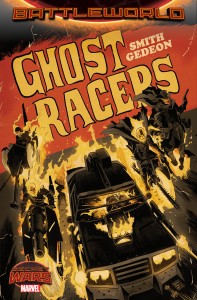 Secret Wars: Inferno #2 (of 4) — Writer: Dennis Hopeless; Art: Javier Garron; Colors: Chris Sotomayor
Secret Wars: Inferno #2 (of 4) — Writer: Dennis Hopeless; Art: Javier Garron; Colors: Chris Sotomayor
Secret Wars: Inhumans: Attilan Rising #2 (of 4) — Writer: Charles Soule; Pencils: John Timms; Inks: Roberto Poggi; Colors: Frank D’Armata
Secret Wars: Marvel Zombies #1 (of 3) — Writer: Simon Spurrier; Art: Kev Walker; Colorts: Frank D’Armata
Secret Wars: Mrs. Deadpool and the Howling Commandos #1 (of 3) — Writer: Gerry Duggan; Art: Salva 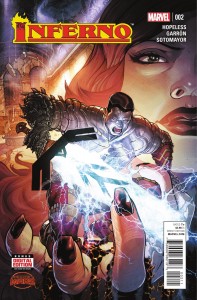 Espin; Colors: Val Staples
Espin; Colors: Val Staples
The first half of the Secret Wars books (in alphabetical order): Captain Marvel has Carol leading a squadron of female pilots who patrol the skies of their section of Doom’s planet — but things keep not quite adding up, and they start to wonder about everything they’ve been taught about the world…. and, since it’s by the book’s regular creative team of DeConnick and Lopez, you know it’s smartly written and good-looking. Ghost Racers is about an arena (a “killiseum”) where, each night, the various incarnations of Ghost Rider race each other. The master of ceremonies is Arcade, so you know there’s something shady about it, and most of the focus is on Robbie Reyes, 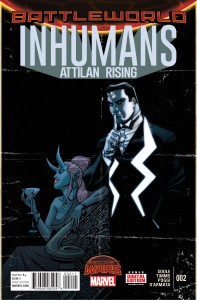 the latest incarnation of the character (the mangafied one where he raced a flaming car instead of a motorcycle, and artist Gedeon keeps that style here), although if you’re a GR fan there’s plenty of others from the tangled history of the book, all the way back to the Western version. Appropriately for a racing story, it moves fast, and offers more than enough action to maintain readers’ interest. Inferno continues its title’s look at that ’90s X-Men era, with Colossus and what’s left of the team fighting to rescue a demonic Illyana, who’s in charge of a hellish New York City and has been battling challenger Madelyne Pryor for it (if you were reading X-books twenty years ago, that sentence makes perfect sense; if not, there’s a recap page at the beginning, and writer Hopeless does a decent-enough
the latest incarnation of the character (the mangafied one where he raced a flaming car instead of a motorcycle, and artist Gedeon keeps that style here), although if you’re a GR fan there’s plenty of others from the tangled history of the book, all the way back to the Western version. Appropriately for a racing story, it moves fast, and offers more than enough action to maintain readers’ interest. Inferno continues its title’s look at that ’90s X-Men era, with Colossus and what’s left of the team fighting to rescue a demonic Illyana, who’s in charge of a hellish New York City and has been battling challenger Madelyne Pryor for it (if you were reading X-books twenty years ago, that sentence makes perfect sense; if not, there’s a recap page at the beginning, and writer Hopeless does a decent-enough 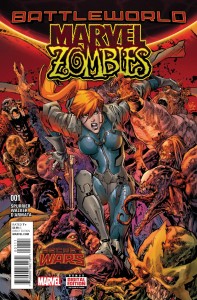 job filling in the background as he moves along); some sly humor and effective art (the demonic version of Nightcrawler,, for instance) make this an above-average offering. Inhumans could also double as a Ms. Marvel book for the month, since Kamala Khan plays a major role in it; it has Medusa as Doom’s appointed regent of their section of Battleworld, battling a freedom-fighting resistance led by Black Bolt — who owns a very upscale bar called the Quiet Room, where denizens from across the planet can meet; he can talk in this incarnation, and is very James Bond-ish. Marvel Zombies is about just what you think it is: the section of Battleworld beyond The Shield, where all the undead prey; Elsa Bloodstone, who’s been manning the wall as a
job filling in the background as he moves along); some sly humor and effective art (the demonic version of Nightcrawler,, for instance) make this an above-average offering. Inhumans could also double as a Ms. Marvel book for the month, since Kamala Khan plays a major role in it; it has Medusa as Doom’s appointed regent of their section of Battleworld, battling a freedom-fighting resistance led by Black Bolt — who owns a very upscale bar called the Quiet Room, where denizens from across the planet can meet; he can talk in this incarnation, and is very James Bond-ish. Marvel Zombies is about just what you think it is: the section of Battleworld beyond The Shield, where all the undead prey; Elsa Bloodstone, who’s been manning the wall as a 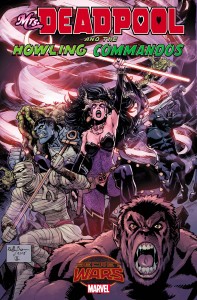 commander, gets knocked hundreds of miles behind enemy lines, and has to survive. Spurrier, a fellow Brit, does a good job getting Bloodstone’s snarky attitude and stiff-upper-lip heroism right, and the zombie versions of regular Marvel characters — particularly Dr. Octopus and the Juggernaut, here — are as fun as always. The week’s weirdest tie-in (and the one with the longest title) is Mrs. Deadpool and the Howling Commandos, wherein the Mrs. is Lady Shiklah, Dracula’s consort, who ends up with the Lord of the Undead after he kills Wade (who, of course, is still narrating the comic as a ghostly Masterpiece Theater-like host). The book’s really about the section of Battleworld where all the monster characters (Werewolf By Night, Frankenstein’s Monster, the Living Mummy, etc.) hang out; they’re the “commandos” of the title, so anyone looking for WW II Sgt. Fury action will be disappointed.
commander, gets knocked hundreds of miles behind enemy lines, and has to survive. Spurrier, a fellow Brit, does a good job getting Bloodstone’s snarky attitude and stiff-upper-lip heroism right, and the zombie versions of regular Marvel characters — particularly Dr. Octopus and the Juggernaut, here — are as fun as always. The week’s weirdest tie-in (and the one with the longest title) is Mrs. Deadpool and the Howling Commandos, wherein the Mrs. is Lady Shiklah, Dracula’s consort, who ends up with the Lord of the Undead after he kills Wade (who, of course, is still narrating the comic as a ghostly Masterpiece Theater-like host). The book’s really about the section of Battleworld where all the monster characters (Werewolf By Night, Frankenstein’s Monster, the Living Mummy, etc.) hang out; they’re the “commandos” of the title, so anyone looking for WW II Sgt. Fury action will be disappointed.
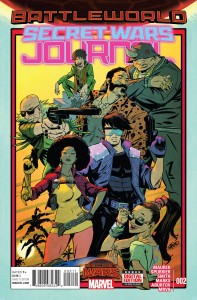 Secret Wars: Journal #2 (of 4) — (First Story): Writer: Kevin Maurer; Art: Cory Smith; Colors: Jesus Aburtov; (Second Story): Writer: Simon Spurrier; Art: Jonathan Marks; Colors: Miroslav Mrva
Secret Wars: Journal #2 (of 4) — (First Story): Writer: Kevin Maurer; Art: Cory Smith; Colors: Jesus Aburtov; (Second Story): Writer: Simon Spurrier; Art: Jonathan Marks; Colors: Miroslav Mrva
Secret Wars: 2099 #2 (of 5) — Writer: Peter David; Art: Will Sliney; Colors: Antonio Fabela
Secret Wars: 1602: Witch Hunter Angela #1 (of 3) — Writers: Marguerite Bennett and Kieron Gillen; Art: Stephanie Hans and Marguerite Sauvage
Secret Wars: Spider-Verse #2 (of 4) — Writer: Mike Costa; 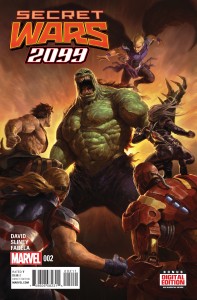 Art: Andre Aravjo; Colors: Rachelle Rosenberg
Art: Andre Aravjo; Colors: Rachelle Rosenberg
Secret Wars: Ultimate End #2 (of 4) — Writer: Brian Michael Bendis; Pencils: Mark Bagley; Inks: Drew Hennessy; Colors: Justin Ponsor
Secret Wars: Weirdworld #1 (of 3) — Writer: Jason Aaron; Art: Mike del Mundo; Colors: del Mundo and Marco 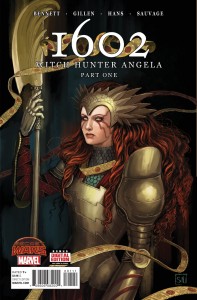 D’Alfonso
D’Alfonso
The other half of the Secret Wars books — Journal is an anthology title, with the first ten-page story involving Paladin and Misty Knight as cops in Killville (the city of assassins from the M.O.D.O.K. comic), ending up in a casino run by Kraven the Hunter; the second tale has Matt Murdock and Elektra in a literal Hell’s Kitchen run by Mr. Sinister and his various clones. One 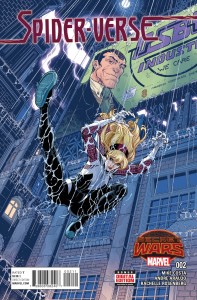 story ends happily and one sadly, and both have interesting art by little-known creators, that kind of variety being the biggest advantage of an anthology like this. 2099 is exactly what it says, with Peter David (who scripted some of the original books in that series, over twenty years ago) using a number of the characters from its future-Marvel timeline (including one who’s kind of a surprise reveal in the story, but is figured prominently on the cover… whoops); it’s another case where is you were a fan of the earlier books, you’ll appreciate a return to that
story ends happily and one sadly, and both have interesting art by little-known creators, that kind of variety being the biggest advantage of an anthology like this. 2099 is exactly what it says, with Peter David (who scripted some of the original books in that series, over twenty years ago) using a number of the characters from its future-Marvel timeline (including one who’s kind of a surprise reveal in the story, but is figured prominently on the cover… whoops); it’s another case where is you were a fan of the earlier books, you’ll appreciate a return to that 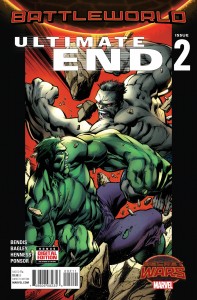 era. So too with another date, 1602: Witch Hunter Angela, as the Elizabethan-era Marvel versions from Neil Gaiman’s series (which was, amazingly, over a decade ago now) go through their paces, benefitting from some nicely-ethereal art by Stephanie Hans, and a plot involving a number of then-current playwrights. Spider-Verse continues its look at a section of Battleworld with many of the Spidey variants (including the Gwen Stacy and cartoon-pig ones), with art that’s energetic but a little too exaggerated for its own good. Ultimate End ties with
era. So too with another date, 1602: Witch Hunter Angela, as the Elizabethan-era Marvel versions from Neil Gaiman’s series (which was, amazingly, over a decade ago now) go through their paces, benefitting from some nicely-ethereal art by Stephanie Hans, and a plot involving a number of then-current playwrights. Spider-Verse continues its look at a section of Battleworld with many of the Spidey variants (including the Gwen Stacy and cartoon-pig ones), with art that’s energetic but a little too exaggerated for its own good. Ultimate End ties with 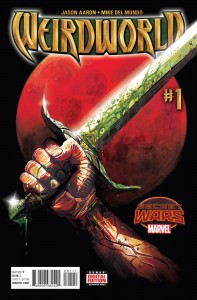 Captain Marvel as the best tie-in of the week, with its Bendis/Bagley look at both the regular-Marvel and Ultimate characters co-existing in a New York City section of Doom’s planet — with two Tony Starks and their relationship providing most of the fun, although, as the cover suggests, two Bruce Banners add quite a bit of excitement, too. That leaves Weirdworld, which bares little resemblance to its original, Tolkein-inspired version from the ’70s, but counters it with striking painted art and coloring from Mike del Mundo, illustrating a picaresque plot from Jason Aaron and making it the most experimental and unique-looking book of the week.
Captain Marvel as the best tie-in of the week, with its Bendis/Bagley look at both the regular-Marvel and Ultimate characters co-existing in a New York City section of Doom’s planet — with two Tony Starks and their relationship providing most of the fun, although, as the cover suggests, two Bruce Banners add quite a bit of excitement, too. That leaves Weirdworld, which bares little resemblance to its original, Tolkein-inspired version from the ’70s, but counters it with striking painted art and coloring from Mike del Mundo, illustrating a picaresque plot from Jason Aaron and making it the most experimental and unique-looking book of the week.
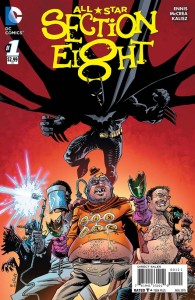 All-Star Section Eight #1 — Writer: Garth Ennis; Art: John McRea; Colors: John Kalisz
All-Star Section Eight #1 — Writer: Garth Ennis; Art: John McRea; Colors: John Kalisz
Constantine: The Hellblazer #1 — Writers: Ming Doyle and James Tynion IV; Art: Riley Rossmo; Colors: Ivan Plascensia
Earth 2: Society #1 — Writer: Daniel H. Wilson; Art: Jorge Jimenez; Colors: John Rauch
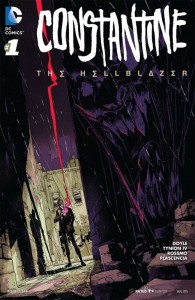 Red Hood/Arsenal #1 — Writer: Scott Lobdell; Art: Denis Meori; Colors: Tanya Horie
Red Hood/Arsenal #1 — Writer: Scott Lobdell; Art: Denis Meori; Colors: Tanya Horie
Starfire #1 — Writers: Amanda Connor and Jimmy Palmiotti; Pencils: Emanuela Lupacchino; Inks: Ray McCarthy; Colors: Hi-Fi
All the DC debut issues — although four of the five are actually continuations/reboots of currently-published books. Even the newcomer, All-Star Section Eight, is creators Ennis and McCrea using supporting characters 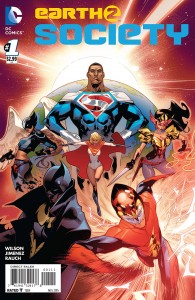 from their acclaimed Hitman run from a decade ago — and it’s Ennis in Boys (or, even more broadly, Dicks) mode, going for gross-out comedy and not for the realism of War Stories or the horror of Crossed. As Boys showed, Ennis is a master at taking the piss out of the superhero concept, and with an artist as good as McRea he’s in top form here; Batman guests in the first issue, and they have a lot of fun doing tribute panels to some of his classic Neal Adams, Jim Aparo and Kelley Jones poses, except under much-less-dramatic circumstances. Buy this, so it sticks around for awhile, and lets these guys
from their acclaimed Hitman run from a decade ago — and it’s Ennis in Boys (or, even more broadly, Dicks) mode, going for gross-out comedy and not for the realism of War Stories or the horror of Crossed. As Boys showed, Ennis is a master at taking the piss out of the superhero concept, and with an artist as good as McRea he’s in top form here; Batman guests in the first issue, and they have a lot of fun doing tribute panels to some of his classic Neal Adams, Jim Aparo and Kelley Jones poses, except under much-less-dramatic circumstances. Buy this, so it sticks around for awhile, and lets these guys 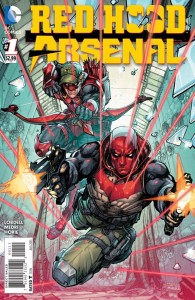 play with DC’s hero toys. Of the other new books, Constantine is the same chain-smoking roguish Brit as ever– except that here he’s being drawn by indy artist Riley Rossmo, who brings an interesting perspective, a clear line and a necessary dash of humor to the character. John’s always been lucky with his creative teams, and this incarnation’s no exception. Earth 2 offers the same Justice Society characters we’ve grown used to in the New 52, except that after the events of Worlds End and Convergence their Earth is gone, and the surviving population has settled on a new planet; this issue picks up a
play with DC’s hero toys. Of the other new books, Constantine is the same chain-smoking roguish Brit as ever– except that here he’s being drawn by indy artist Riley Rossmo, who brings an interesting perspective, a clear line and a necessary dash of humor to the character. John’s always been lucky with his creative teams, and this incarnation’s no exception. Earth 2 offers the same Justice Society characters we’ve grown used to in the New 52, except that after the events of Worlds End and Convergence their Earth is gone, and the surviving population has settled on a new planet; this issue picks up a 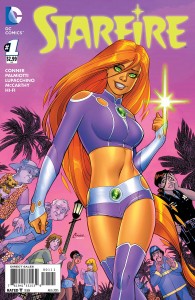 year after planetfall, and offers a good beginning that mixes familiar characters into a new setting. Red Hood/Arsenal is just Red Hood and the Outlaws minus Starfire (it’s even still written by Scott Lobdell), so it’s pretty much the same book. Kory, meanwhile, has gotten her own solo comic; the good news is that it’s written by the Harley Quinn team of Amanda Connor and Jimmy Palmiotti. That means (a) we get cool Connor covers, and (b) there’s more solid character development of her innocent-alien persona than in the last three years of her former title. This is a book that old Teen Titans fans, especially, might be interested in.
year after planetfall, and offers a good beginning that mixes familiar characters into a new setting. Red Hood/Arsenal is just Red Hood and the Outlaws minus Starfire (it’s even still written by Scott Lobdell), so it’s pretty much the same book. Kory, meanwhile, has gotten her own solo comic; the good news is that it’s written by the Harley Quinn team of Amanda Connor and Jimmy Palmiotti. That means (a) we get cool Connor covers, and (b) there’s more solid character development of her innocent-alien persona than in the last three years of her former title. This is a book that old Teen Titans fans, especially, might be interested in.
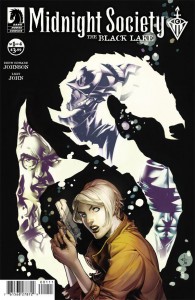 Midnight Society: The Black Lake #1 (of 4) — Writer/Artist: Drew Edward Johnson; Colors: Lizzy John
Midnight Society: The Black Lake #1 (of 4) — Writer/Artist: Drew Edward Johnson; Colors: Lizzy John
Starve #1 — Writer: Brian Wood; Art: Danijel Zezelj; Colors: Dave Stewart
Long Distance #1 — Creator: Thom Zahler
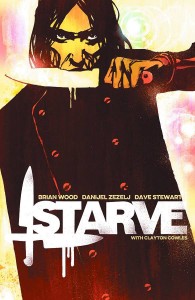 The Disciples #1 — Writer: Steve Niles; Art: Christopher Mitten; Colors: Jay Fotos
The Disciples #1 — Writer: Steve Niles; Art: Christopher Mitten; Colors: Jay Fotos
Four indy first issues — Midnight Society is an above-average example of one of those occult-investigator team books, while Starve is about a near-future high-tech-but-sort-of dystopian future like Transmetropolitan, where a famous-but-retired practioner 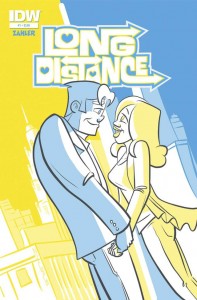 gets pulled back into the game, except it’s set in the world of competetive reality chef shows instead of journalism. Long Distance is a romantic comedy about a couple who meet not-too-cute in an airport and begin a long-distance relationship, and offers no superhero or other gimmicks except its appealing just-slightly-
gets pulled back into the game, except it’s set in the world of competetive reality chef shows instead of journalism. Long Distance is a romantic comedy about a couple who meet not-too-cute in an airport and begin a long-distance relationship, and offers no superhero or other gimmicks except its appealing just-slightly-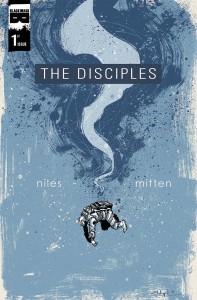 Archieish cartoony style; it has a page full of pull quotes from people like Mark Waid and Kurt Busiek, and they all use words like “charming” and “warm,” because, well, it’s heart-warming and charming. At 44 pages for $4.99, it’s a good deal, too: a skillful, fun exploration of comics as a storytelling medium. The Disciples is an astronaut/occult book from horror writer Steve Niles, and benefits from a couple of really nice Mitten splash pages of Jupiter and its planets (the mission is to Ganymede), and a wtf? final page.
Archieish cartoony style; it has a page full of pull quotes from people like Mark Waid and Kurt Busiek, and they all use words like “charming” and “warm,” because, well, it’s heart-warming and charming. At 44 pages for $4.99, it’s a good deal, too: a skillful, fun exploration of comics as a storytelling medium. The Disciples is an astronaut/occult book from horror writer Steve Niles, and benefits from a couple of really nice Mitten splash pages of Jupiter and its planets (the mission is to Ganymede), and a wtf? final page.
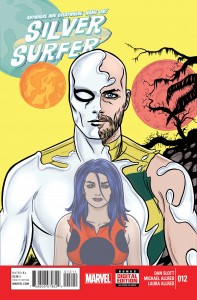 Silver Surfer #12 — Writer: Dan Slott; Art: Michael Allred; Colors: Laura Allred
Silver Surfer #12 — Writer: Dan Slott; Art: Michael Allred; Colors: Laura Allred
Batman #41 — Writer: Scott Snyder; Pencils: Greg Capullo; Inks: Danny Miki; Colors: FCO Plascensia
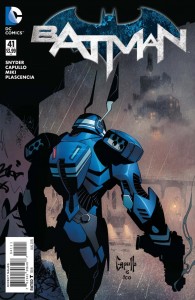 Batman/Superman #21 — Writer: Greg Pak; Pencils: Ardian Syaf; Inks: Ulises Arreola; Colors: Syaf, Danny Miki and Arreola
Batman/Superman #21 — Writer: Greg Pak; Pencils: Ardian Syaf; Inks: Ulises Arreola; Colors: Syaf, Danny Miki and Arreola
Many books left; little time. These three are the other mainstream superhero books that stood out: Silver Surfer because Slott and the Allreds have crafted a solid, feel-good first-season romance for their hero that concludes here, 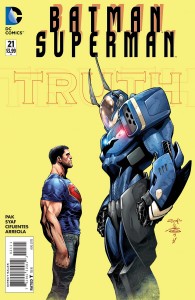 just the way it should; it’s going to make a killer trade collection when it’s all in one place. Batman is at one of those points in its storytelling evolution where Bruce Wayne is “dead,” and so Commissioner Gordon, slimmed down and shaved, agrees to strap into a robotic bat-suit. It’s better than it sounds (I’m pretty sure it would have to be…), with a what-the-hell buzz that rockets it along painlessly. Even better is Batman/Superman, with its face-off of a depowered Clark Kent and the cop-sponsored Gordon Batman; it’s one of those books I’d have thought was super-cool when I was fifteen, and more power to it.
just the way it should; it’s going to make a killer trade collection when it’s all in one place. Batman is at one of those points in its storytelling evolution where Bruce Wayne is “dead,” and so Commissioner Gordon, slimmed down and shaved, agrees to strap into a robotic bat-suit. It’s better than it sounds (I’m pretty sure it would have to be…), with a what-the-hell buzz that rockets it along painlessly. Even better is Batman/Superman, with its face-off of a depowered Clark Kent and the cop-sponsored Gordon Batman; it’s one of those books I’d have thought was super-cool when I was fifteen, and more power to it.
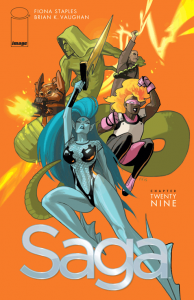 Saga #29 — Writer: Brian K. Vaughan; Art/Colors: Fiona Staples
Saga #29 — Writer: Brian K. Vaughan; Art/Colors: Fiona Staples
Crossed Plus One Hundred #5 — Writer: Alan Moore; Art: Gabriel Andrade; Color: Digikore Studios
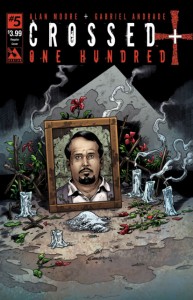 Descender #4 — Writer: Jeff Lemire; Art/Colors: Dustin Nguyen
Descender #4 — Writer: Jeff Lemire; Art/Colors: Dustin Nguyen
Injection #2 — Writer: Warren Ellis; Art: Declan Shalvey; Colors: Jordie 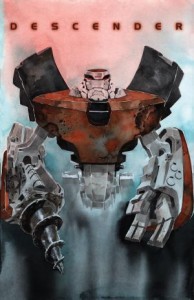 Bellaire
Bellaire
Nameless #4 — Writer: Grant Morrison; Art: Chris Burnham; Colors: Nathan Fairbairn
 Rachel Rising #34 — Creator: Terry Moore
Rachel Rising #34 — Creator: Terry Moore
Rebels #3 — Writer: Brian Wood; Art: Andrea Mutti; Colors: Jordie Bellaire
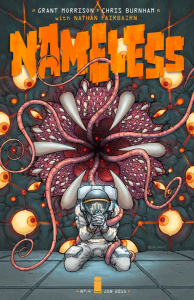 The Fox #3 — Writers: Dean Haspiel and Mark Waid; Art: Dean Haspiel
The Fox #3 — Writers: Dean Haspiel and Mark Waid; Art: Dean Haspiel
Miami Vice: Remix #4 — Writer: Joe Casey; Art: Jim 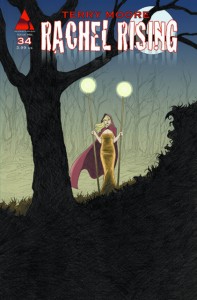 Mahfood; Colors: Justin Stewart and Steven Chunn
Mahfood; Colors: Justin Stewart and Steven Chunn
The indy stuff I couldn’t resist: Saga for its space-opera, twist-a-minute thrills, deft characterization 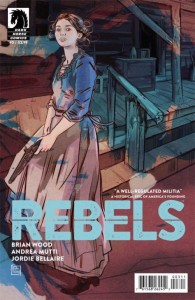 and beautiful art; Crossed Plus One Hundred for Moore’s expert slow-horrific-realization build, and for his play with language; Descender for Lemire’s Jonny Quest–
and beautiful art; Crossed Plus One Hundred for Moore’s expert slow-horrific-realization build, and for his play with language; Descender for Lemire’s Jonny Quest–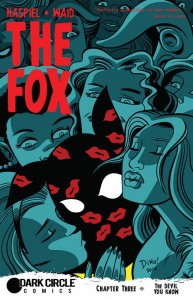 adventure-style boy-robot plot and Nguyen’s dreamlike painterly drawings; Injection for its typically-Ellis Challengers of the Unknown set-up and for Shalvey’s art; Nameless for the way it doubles down on Grant Morrison’s ’60s-era
adventure-style boy-robot plot and Nguyen’s dreamlike painterly drawings; Injection for its typically-Ellis Challengers of the Unknown set-up and for Shalvey’s art; Nameless for the way it doubles down on Grant Morrison’s ’60s-era 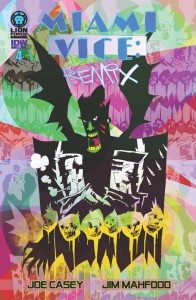 Michael Moorcockish paranoia; Rachel Rising for its serial-horror pleasures (it’s like a good occult cable show, and Moore, no surprise, has created an appealing, tight-knit cast for it); Rebels for its deeply-researched Revolutionary War setting and its quietly-stunning Mutti art; The Fox and Miami Vice: Remix because, my god, look at them, one all Apollonion Alex Toth formalism and the other all raging underground go-for-it energy — they’re very different but each essential, and as good a place as any to end the week.
Michael Moorcockish paranoia; Rachel Rising for its serial-horror pleasures (it’s like a good occult cable show, and Moore, no surprise, has created an appealing, tight-knit cast for it); Rebels for its deeply-researched Revolutionary War setting and its quietly-stunning Mutti art; The Fox and Miami Vice: Remix because, my god, look at them, one all Apollonion Alex Toth formalism and the other all raging underground go-for-it energy — they’re very different but each essential, and as good a place as any to end the week.


